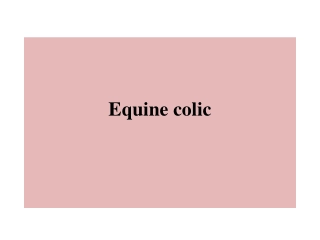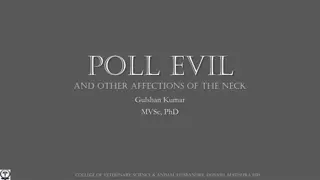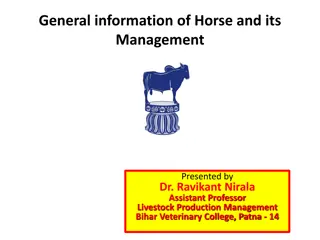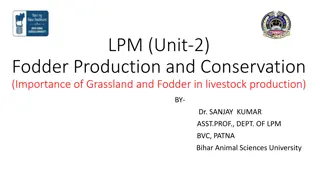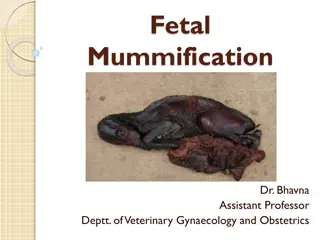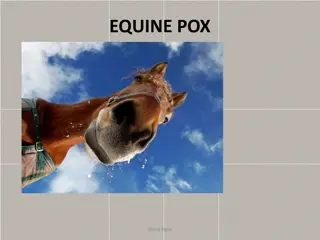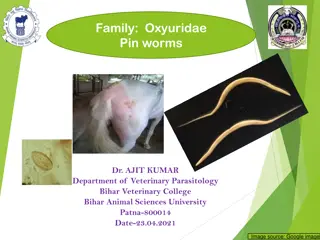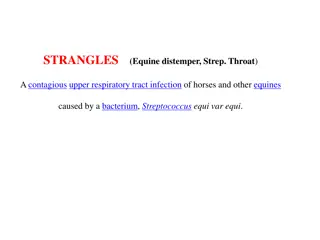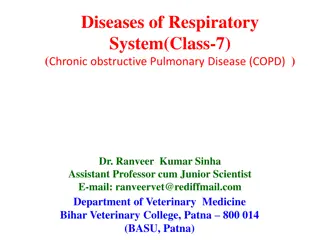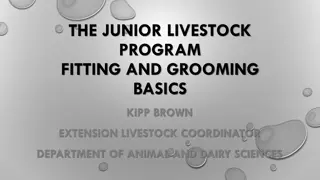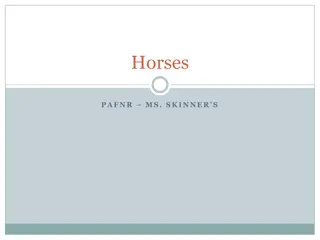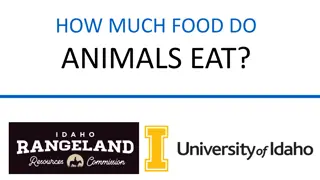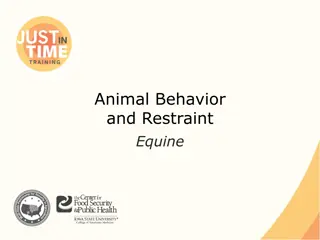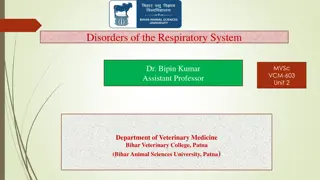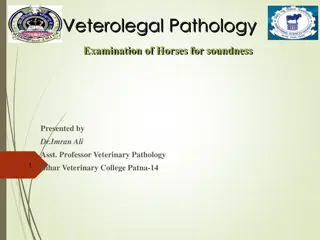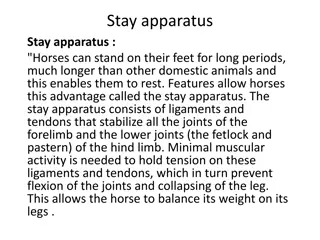Equine colic
Learn about the definition, causes, and types of colic in horses. Discover how to treat and prevent this potentially deadly condition.
0 views • 18 slides
Information Security – Theory vs. Reality
Exploring the concept of fault attacks in hardware security, this lecture delves into the various techniques used to compromise systems through non-nominal and nominal channels, as well as the potential risks introduced by trojan horses in the IT supply chain. The discussion includes differential fa
2 views • 37 slides
Problem Solving December 2023
Officials in equestrian events have roles including ensuring the best interests of horses and athletes, promoting integrity and risk management, and fostering partnerships with competitors and organizers. Procedures for inquiries, protests, and appeals are also outlined, highlighting the importance
1 views • 19 slides
Understanding Poll Evil and Yoke Gall in Horses: Symptoms and Treatment
Poll evil and yoke gall are common afflictions affecting horses, particularly in the neck region. Poll evil is an inflammatory condition characterized by a painful swelling at the top of the neck, while yoke gall is localized acute inflammation caused by yoke pressure. Poll evil is typically treated
0 views • 8 slides
Horse Management and Common Terminology Overview
Dr. Ravikant Nirala, Assistant Professor at Bihar Veterinary College, presents comprehensive information on horse management and common terminology associated with equine production. The content covers the position of horses in the animal kingdom, terminology for different horse genders and ages, mi
1 views • 15 slides
Understanding Large Strongyles in Horses: Superfamily Strongyloidea
Explore the world of large strongyles in horses, specifically focusing on the Superfamily Strongyloidea. Discover key features of strongyle morphology, their presence in different animals, and detailed insights into species like Strongylus vulgaris. Learn about the life-cycle, prepatent periods, and
0 views • 49 slides
Importance of Green Fodder in Livestock Production by Dr. Sanjay Kumar
Fodder, essential for livestock like cattle, rabbits, and horses, includes hay, silage, and fresh forage plants. Green fodder provides easily digestible nutrients, essential for animal health and milk production. While concentrates may boost production, green fodder remains economical and vital due
1 views • 11 slides
Accounting Treatment of Casual Incomes and Interest on Securities in Income Tax
This content discusses the accounting treatment of casual incomes and interest on securities in income tax, presented through two problems with solutions. The first problem involves computing income from other sources based on lottery winnings and betting amounts. The second problem deals with calcu
0 views • 13 slides
Understanding Fetal Mummification in Domestic Animals
Failure in pregnancy stages can lead to fetal mummification, characterized by autolytic changes, mummification process, and dry, leathery tissue. Events required for mummification include fetal death post-bone development, rapid resorption of fluids, absence of oxygen and bacteria. This process is c
2 views • 27 slides
Understanding Glanders: Causes, Symptoms, and Transmission
Glanders, also known as Farcy, Equinia, or Malleus, is a contagious disease affecting horses, mules, and donkeys. It is caused by the bacteria Pseudomonas mallei and can be transmitted through direct contact or inhalation. The disease manifests with nodules or ulcers in the respiratory tract and on
0 views • 11 slides
Equine Coital Exanthema: Overview, Symptoms, and Management
Equine coital exanthema, caused by Equine Herpesvirus 3, is a contagious venereal disease affecting horses globally. It primarily manifests as genital lesions in stallions and mares, transmitted sexually or through contact with contaminated materials. While it is typically self-limiting, it can be p
0 views • 23 slides
Understanding Oxyuris equi: Horse Pinworm Infection
Explore the general characteristics, hosts, life cycle, transmission, and pathogenesis of Oxyuris equi, a pinworm that infects horses and donkeys. Learn about its unique features, including the hour-glass-shaped oesophagus, mating behavior, and effects on its hosts.
0 views • 13 slides
Understanding Strangles in Horses: Symptoms, Treatment, and Complications
Strangles, also known as Equine Distemper, is an infectious disease affecting horses and equids. It is characterized by upper respiratory tract infection, lymph node abscesses, and various complications. Symptoms include nasal discharge, coughing, and swelling of lymph nodes. Prompt diagnosis and tr
3 views • 11 slides
Understanding Strangles in Horses: Causes, Symptoms, and Treatment
Strangles is a contagious upper respiratory tract infection in horses caused by Streptococcus equi var equi. It is characterized by inflammation, swelling, and lymph node abscesses. Transmission occurs through direct or indirect contact, leading to symptoms like depression, fever, nasal discharge, a
0 views • 11 slides
Understanding Azoturia in Horses: Causes, Symptoms, and Treatment
Azoturia, also known as exertional rhabdomyolysis or tying-up syndrome, is a multifactorial myopathy that mainly affects draft horses. It is characterized by stiffness in gait, reluctance to move, lameness, and myoglobinuria. The disease typically occurs during exercise after a period of rest and ca
0 views • 14 slides
Chronic Obstructive Pulmonary Disease (COPD) in Horses: A Veterinarian's Perspective
Chronic Obstructive Pulmonary Disease (COPD) in horses is a respiratory condition caused by hypersensitivity reactions to allergens, viral infections, or bronchopneumonia. This chronic respiratory disease leads to decreased work performance, chronic coughing, abnormal lung sounds, and cardiac dysfun
0 views • 17 slides
Veterinary Update on Equine Worming Protocols
Explore the latest insights on equine worming practices, including details on common types of worms, clinical signs, prevention, treatment, and diagnostic methods. Learn about dealing with threadworms, tapeworms, pinworms, bots, and lungworms in horses and donkeys.
0 views • 36 slides
Understanding Malware: Types, Usage, and Protection
Malware, short for malicious software, encompasses various forms of hostile software designed to disrupt computer operation, steal sensitive information, or gain unauthorized access. It includes viruses, trojan horses, worms, spyware, phishing, ransomware, and more. Malware is often used to steal pe
1 views • 49 slides
Exploring 4-H Equine Cloverbud Opportunities
Delve into the world of 4-H Equine Cloverbuds where young horse enthusiasts can participate in a variety of activities such as Horse Bowl, County Shows, Western Games, and more. Cloverbuds can engage in the Horseless Horse project to learn about equine care, breeds, grooming, and tack. They can also
0 views • 9 slides
Understanding Web 2.0 and Online Security Threats
Explore the evolution of Web 2.0, the concept of Read/Write web, the significance of blogs and wikis, and the impact of social media sites. Learn about the risks posed by malware, trojan horses, viruses, and worms in the online landscape.
0 views • 14 slides
Monogenetic Disorders in Noriker Horses: Implications for Conservation Breeding Programs
This study explores monogenetic disorders, specifically PSSM Type1, in Noriker horses, highlighting the impact of GYS1 gene mutation on breeding practices. The research delves into carrier frequencies across diverse horse breeds and emphasizes the importance of genetic screening in conservation bree
1 views • 18 slides
Livestock Clipping and Grooming Basics for Show Exhibitors
Explore the essentials of livestock clipping and grooming for show animals, including tips on enhancing their appearance to meet show rules. Learn about the techniques, tools required, and best practices for different species like market steers, hogs, lambs, and goats, as well as breeding cattle and
0 views • 13 slides
Understanding Horse Face and Leg Markings
Learn about different markings found on a horse's face and legs, such as snip, star, strip, blaze, bald face, ermine, combinations, and coronet. These unique patterns create individuality in horses and can range from small spots to large white areas covering the face or leg. They can be symmetrical
0 views • 13 slides
Kentucky Horse Racing: Supporting Equine Breeding in Kentucky
Kentucky offers various incentive programs to support the breeding of Thoroughbreds and Standardbreds, such as the Kentucky Breeders Incentive Fund and the Kentucky Sire Stakes. These programs provide financial rewards to breeders based on the success of their horses in eligible races. Other equine
2 views • 7 slides
Horse Facts and History Overview
Explore interesting facts about horses, including their vocabulary, classifications, and history. Learn about different terms associated with horses, such as filly, mare, stud, and more. Delve into horse-related concepts like gestation, foaling, and unsoundness. Additionally, discover historical mil
0 views • 35 slides
Understanding Phishing, Viruses, and Online Security
The internet can be a dangerous place with threats like viruses, worms, Trojan horses, and phishing scams. Learn how to protect yourself against these cyber threats and secure your personal information online. Be vigilant against email phishing schemes and follow tips to avoid falling victim to onli
0 views • 16 slides
Highlights of Sandy Ridge at Red Mile Horse Racing Event, April 1-6, 2023
Sandy Ridge at Red Mile was a successful horse racing event held from April 1 to 6, 2023. The event featured 6 race days with a total of 36 races and 318 horses programmed. Noteworthy aspects include total purses paid amounting to $1,006,145, positive survey feedback rating, and the emergence of top
0 views • 5 slides
Understanding Malware and Computer Security
Exploring the world of malware and computer security, this content delves into different types of malware such as Trojan horses, viruses, worms, and rootkits. It discusses how malware can violate site security policies and the covert actions they can carry out without detection. Examples like the Ge
0 views • 127 slides
Introduction to Pony Club Rallies: Team Competition in Horse Riding
Pony Club Rallies are team competitions in various disciplines like Show Jumping and Dressage, focusing on promoting horsemanship, responsibility, and teamsmanship among young riders. Participants compete as sole caregivers for their horses, building skills and forming bonds with fellow Pony Club me
0 views • 26 slides
Veterinary Ophthalmology MCQ Sample Questions
Explore multiple-choice questions related to veterinary ophthalmology, covering topics such as orbital anatomy in horses and cattle, refractive states in dogs, choroidal microcirculation in cats, retinoscopy in dogs, and ophthalmic lesions in dogs. Test your knowledge with these challenging question
0 views • 8 slides
How Much Food Do Animals Eat? Daily Consumption Explained
Forage demand varies among animals based on their digestive systems. Hind-gut fermenters consume around 2.5% of their body weight in dry matter forage per day, while ruminants consume 3.0%. Examples provided include cows eating 20% of their body weight, horses eating 3.0%, and rabbits eating 3% dail
0 views • 5 slides
Understanding Blister Beetles and Livestock Toxicity: Impacts and Management
Blister beetles are a biological control agent of grasshoppers but can become a problem, especially during drought years. This presentation discusses how blister beetles develop, their impact on plants and livestock, and the toxicity of cantharidin found in these beetles. Livestock, especially horse
0 views • 9 slides
Understanding Electrolytes and Their Importance for Trail Equine Athletes
Explore the crucial role of electrolytes for competitive trail equine athletes, including their functions, absorption in the body, sources of loss, and homemade electrolyte formulations. Learn how electrolytes such as sodium, potassium, and chloride are essential for muscle function, intestinal moti
0 views • 22 slides
Understanding Equine Influenza: An Overview of Respiratory Tract Infections in Horses
Equine influenza is a contagious upper respiratory infection in horses caused by influenza viruses. This article covers the anatomy of the equine respiratory tract, signs, diagnosis, treatment, prevention, and prognosis of equine influenza. It also discusses the histological structure of the respira
0 views • 18 slides
Promoting Road Safety for Horses and Riders by British Horse Society
Highlighting the importance of road safety for horses and riders, the British Horse Society, led by Alan Hiscox, Director of Safety, aims to educate drivers on safely passing horses on the road. With a focus on reducing incidents and creating a safer environment, the campaign emphasizes the need for
0 views • 28 slides
Nutritional Implications for Developmental Orthopaedic Diseases in Horses
Developmental Orthopaedic Diseases in horses, such as Physitis and Osteochondritis Dissecans, can be influenced by factors like trauma, genetic predisposition, and poor nutrition. Ensuring proper mineral intake, balanced nutrition, and avoiding excess caloric intake at different stages like pregnanc
0 views • 12 slides
Equine Behavior and Restraint: Understanding and Handling Horses
Discover key insights into equine behavior and restraint techniques for safe handling of horses. Explore topics such as normal behavior, body language cues, flight zones, herding and moving horses, capture and containment methods, and post-handling considerations. Enhance your understanding of equin
0 views • 13 slides
Veterinary Guide: Respiratory System Disorders in Horses
Respiratory system disorders in horses are crucial as they can impact the animals' performance and lead to economic losses for owners. Early detection and treatment are essential for ensuring the rapid return of athleticism in performance animals. This guide covers the diagnostic approach to respira
0 views • 9 slides
Veterolegal Pathology: Examination of Horses for Soundness by Dr. Imran Ali, Asst. Professor at Bihar Veterinary College
In the field of veterolegal pathology, examining horses for soundness is crucial for assessing their natural usefulness. This examination involves identifying conditions such as bone spavin, bog spavin, bowed tendon, and curb, each with specific symptoms that indicate unsoundness as per legal defini
0 views • 18 slides
The Anatomy of Horses and Domestic Ruminants
Horses possess a unique stay apparatus that allows them to stand for long periods with minimal muscular activity, while domestic ruminants like cows, sheep, and goats have osseous horns that grow continuously. The stay apparatus in horses consists of ligaments and tendons stabilizing their joints, e
0 views • 6 slides
